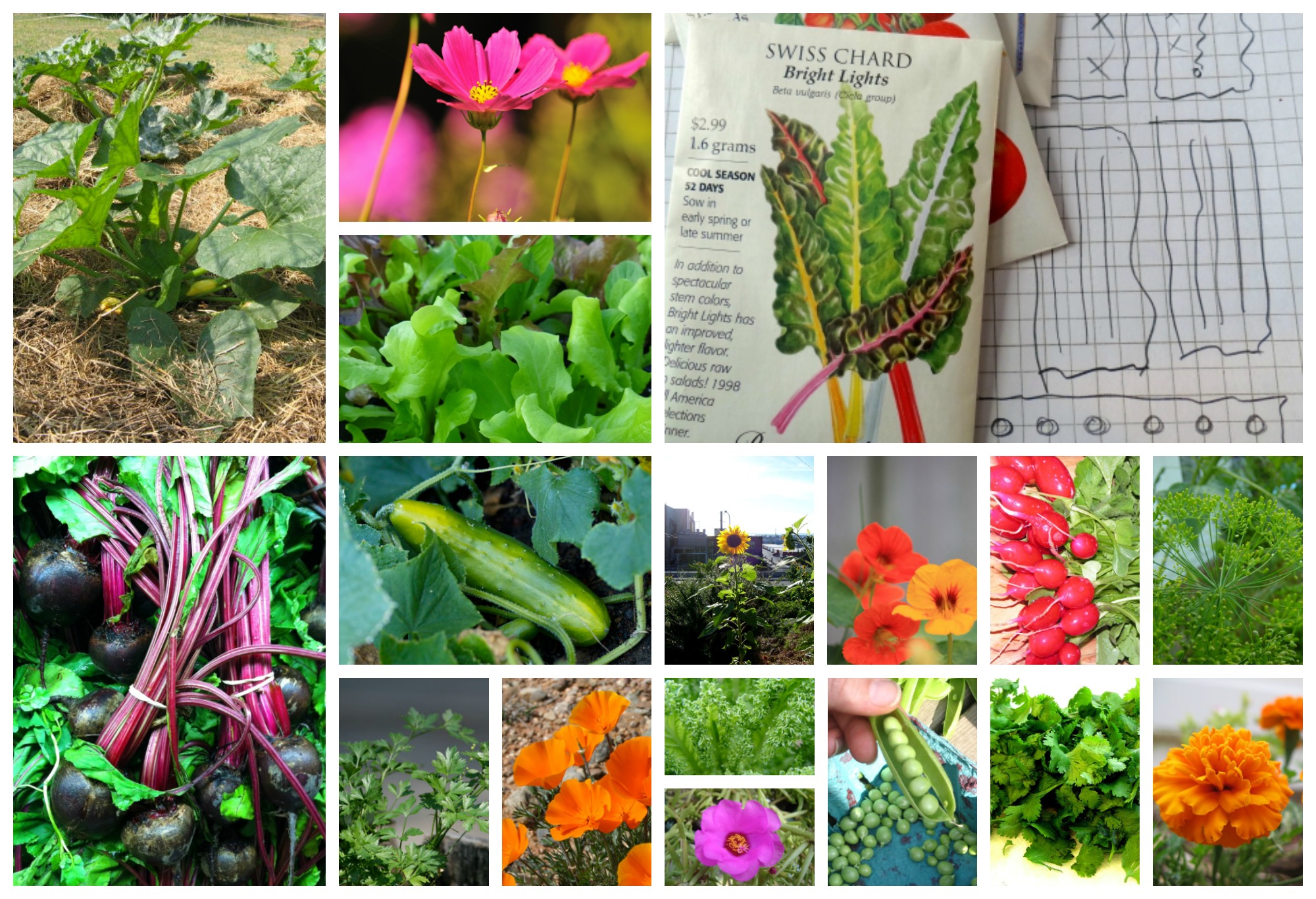If you’re new to flower and vegetable gardening, it can seem overwhelming. There are so many varieties of flowers, herbs and vegetables to plant. Some need to be started indoors six to eight weeks (or longer) before transplanting into the garden. Some need very long growing seasons or special conditions. Some seeds need to be notched, cold stratified, or soaked before planting, and some just need quite a lot of special care. It can be hard to know where to start.
The good news is that there are lots of herbs, vegetables and flowers that are very simple to start from seed. Here are sixteen wonderful ones to start with, along with some basic information on how to plant them and why you’ll love them. See the planting instructions on your individual seed packets for full details for individual varieties.
- Swiss chard: Swiss chard is a workhorse in the garden. Bugs tend to completely leave it alone, making it a great choice for an organic garden. It’s also very high in iron and lots of other vitamins and minerals, making it pack quite a nutritional punch. It grows easily from seed and keeps going until hard frost, tolerating both high heat and pretty impressive cold. Simply cut off leaves with a sharp knife or a pair of scissors an inch above the ground and it’ll keep producing. Rainbow Lights swiss chard is especially gorgeous, with stalks in vivid jewel tones of red and yellow. Use the leaves like spinach in recipes (it’s great in stir fries) or the way you would use collard greens, and the stems like celery in soups and stews.
- Marigolds: Not only are marigolds a fabulous first flower for children to grow (since they are easy to grow from seed, germinate quickly, stay rather compact and tidy and look cute) but they also help repel bugs in the vegetable garden. Most marigolds come in hues of orange and yellow, though some variations are available. Sow these seeds about 1/8″ deep in the garden. You can also easily save the seeds for next year’s garden.
- Radishes: Anybody can grow radishes. You can sow them early in spring without worrying about frost warnings, and they’ll grow quickly and easily. Radishes can be ready to eat less than a month after you plant them! Most people eat radishes raw, either plain or in salads, but they can also be enjoyed in pickled recipes and they are delicious sauteed in butter or olive oil with a pinch of salt.
- Nasturtiums: Nasturtiums pull double duty in the garden because they’re beautiful flowers and they’re also edible (the leaves and flowers have a peppery flavor that’s great in soups, salads and sandwiches). They also require very little in care. Sow these seeds after danger of frost is passed, in a moist, sunny spot.
- Lettuce and greens: Salad greens can be started in early spring and produce very quickly. Loose leaf lettuce and greens are easier to harvest than head lettuce, as you can just scatter the seeds and lightly cover them with soil and then consistently thin the plants as they grow to use them in salads (pull up the seedlings roots and all). Plant greens every two to three weeks for crops from spring through fall. In the heat of the summer, they will do better in partial shade (especially if they’re shaded during the heat of the afternoon).
- Cilantro: Cilantro is quite easy to grow from seed but it can present a few problems during the season if you don’t know to anticipate them. Cilantro tends to bolt (grow tall quickly and try to go to seed) in the summer heat. An easy way to get around this is to plant successive plantings and plant summer plantings in partial shade. Cilantro doesn’t taste as good if allowed to go to flower. An easy remedy is to consistently take cuttings (and use it in salsa and dishes!) to keep it compact and keep it from flowering. It can also be good to allow one plant to go to flower and produce seeds, while keeping the others cut back and producing. Make sure to keep the seeds lightly watered until they emerge, and then it’s a a very easy herb to maintain.
- Cosmos: There is nothing not to like about cosmos. They are available in lots of shades and colors (some in the pink and red family, some in the yellow and orange family, along with lots of variations of shape and color) and they attract beneficial insects to the garden, along with birds and butterflies. Cosmos are not picky about your soil or fertilizer, either, and they know when to germinate so you won’t hurt them if you sow them too early. The seeds are incredibly easy to plant. Scatter them on the ground and then barely cover with soil.
- Poppies: Poppies are a lot like cosmos in almost preferring poor soil and a little neglect. Annual poppies should be sown directly into the garden during cool, rainy weather to best germinate the seeds. Once established, they require very little care.
- Sunflowers: Few plants are more magical in the garden than sunflowers. They grow easily from seed and they come in an astounding variety of shapes and sizes, along with a few fun color variation besides the typical yellow. They feed the birds long into fall and they make a grand statement in the back of the garden. Plant seeds 6-12″ apart, directly into moist soil after the danger of frost, then thin them to about 1 1/2′ apart (or 1′ apart for dwarf varieties). Water regularly until they’re established and again in periods of drought. Mulching around the seedlings will help keep weeds at bay so they don’t have to compete.
- Dill: Sow dill seeds about ¼-inch deep and 18 inches apart in rich soil, then gently rake the seeds into the soil and keep watered until established. Dill is beneficial when planted near cabbage and onions. It will reseed itself in the garden the next year if you allow it to go to seed.
- Peas: One secret to success with peas is to start it very early in the spring, as soon as the soil can be worked. In some parts of this country, this can be as early as President’s Day. Peas prefer to grow in cool weather, and it’s best to plan the planting so they’ll be ready to harvest before the heat of the summer. Plant peas in well-drained soil on both sides of a trellis. Fresh shelled peas from the garden are incredibly tasty and a favorite snack for young children, too.
- Beets: Beets are cool weather crops that do best when planted in the early spring. They can also be grown when planted in the late summer for a fall harvest. Beets like plenty of water and lots of sun.
- Summer squash: The hardest thing about growing summer squash varieties like zucchini is figuring out what to do with it all at harvest time. Plant summer squash when the soil has warmed up and all danger of frost is gone. Make sure to give it enough room.
- Kale: Not only is this garden plant nutritious, but it’s easy to grow in seed and will also tolerate frost and cold well. In fact, it tastes better if it gets frost-kissed, making it a great plant for a fall garden. Plane kale in full sun during cooler months or in partial shade during the heat of the summer, 2-4 weeks before last frost or any time from then on for successive crops. Keep the soil moist for sweeter, crisper crops. You can harvest individual leaves (starting at the outside) to keep plants producing.
- Cucumbers: Cucumbers like warm weather, ample sunshine and lots of water. Even one plant will grow an abundance of cucumbers since they grow as bushes. Be sure to give them plenty of space, and wait until warm weather to sow.
- Portulacas (moss roses): These lovely little flowers are perfect for dry areas of the yard or garden. They handle heat and drought with ease, and make colorful groundcovers for problem areas at just 4-6 inches tall. They prefer average to poor soil, especially sandy soil. Plant them shallowly in a sunny spot after all danger of frost has passed. Finely mist the area and keep it lightly watered until they germinate (generally about 8-12 days). Deadhead (pinch off the spent flowers) to keep them blooming nonstop all summer.
Seed starting tips:
- Remember to follow directions on individual seed packets for best results.
- Always plant in full sun unless otherwise noted, and be sure to keep weeds at bay, especially when seedlings are first becoming established.
- If you have poor soil, it helps to dig in some compost or other organic material (such as shredded leaves) before planting.
- In general, expect to keep seeds well watered until seedlings are established, and then water only as needed. Try to keep water fairly consistent, though, to encourage proper growth. Some veggies will not produce good yields without regular watering. In general, expect to have to water veggies with high water contents such as cucumbers regularly, while most herbs and flowers will tolerate less water.
- Once your seedlings are up, mulch will help your garden succeed. Mulch keeps weeds down, retains the soil’s moisture and cuts your garden maintenance time dramatically. Good sources of organic mulch are straw, fall leaves, grass clippings and wood shavings. Another benefit of natural mulch is that it slowly improves your soil with every garden season.
Your first garden will involve a steep learning curve. Some plants may fail, but most will thrive even in the face of early gardening mistakes.
Happy growing!






